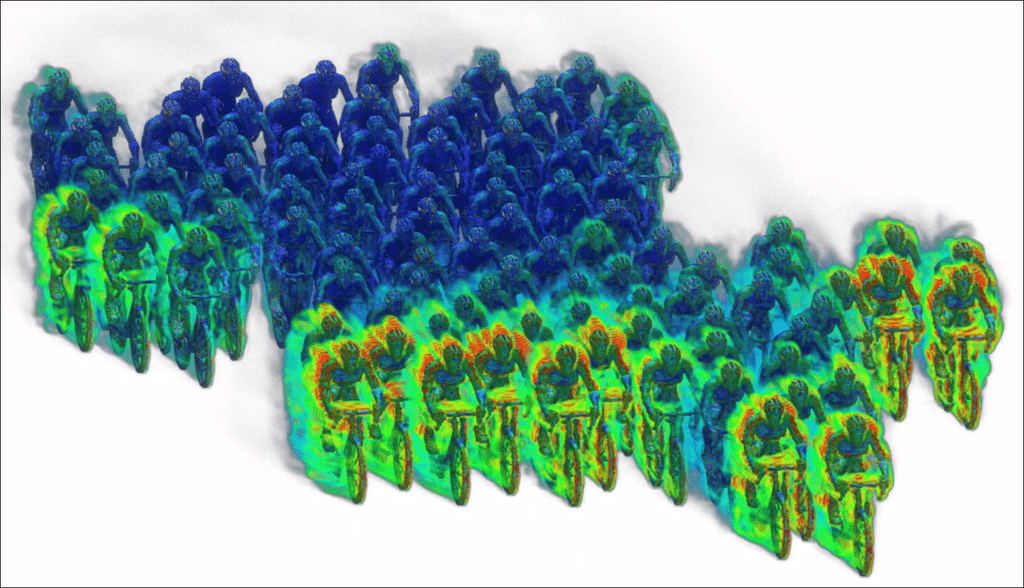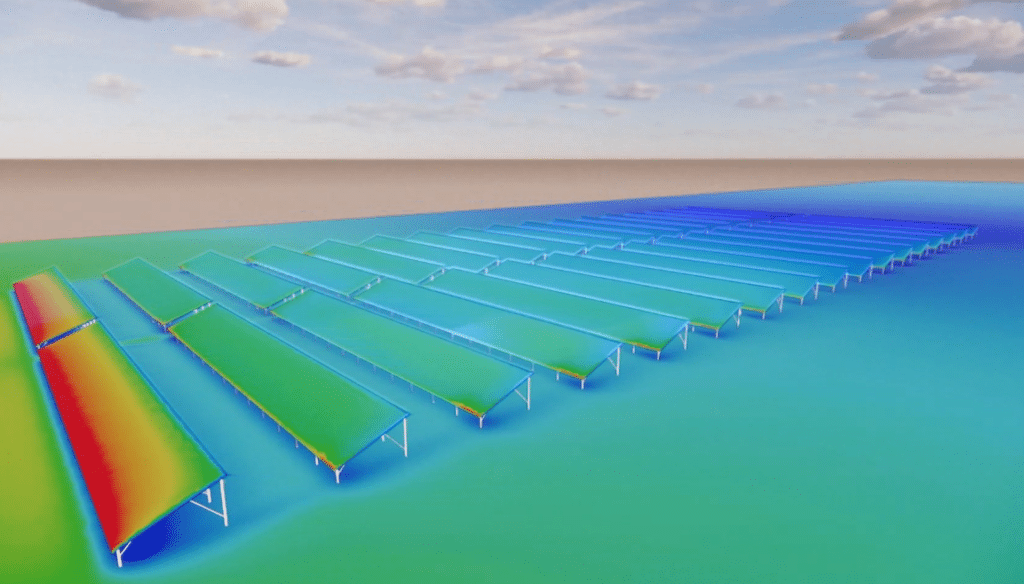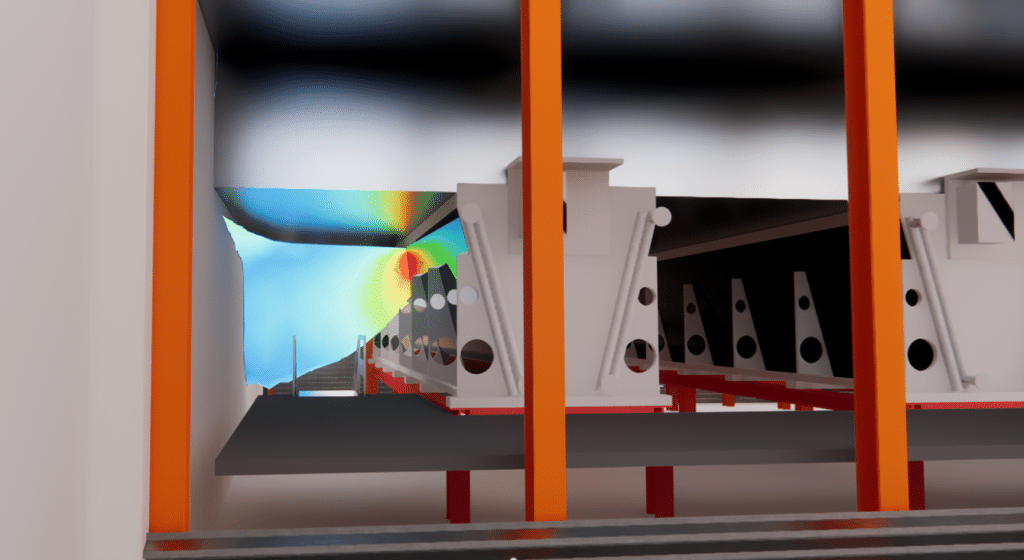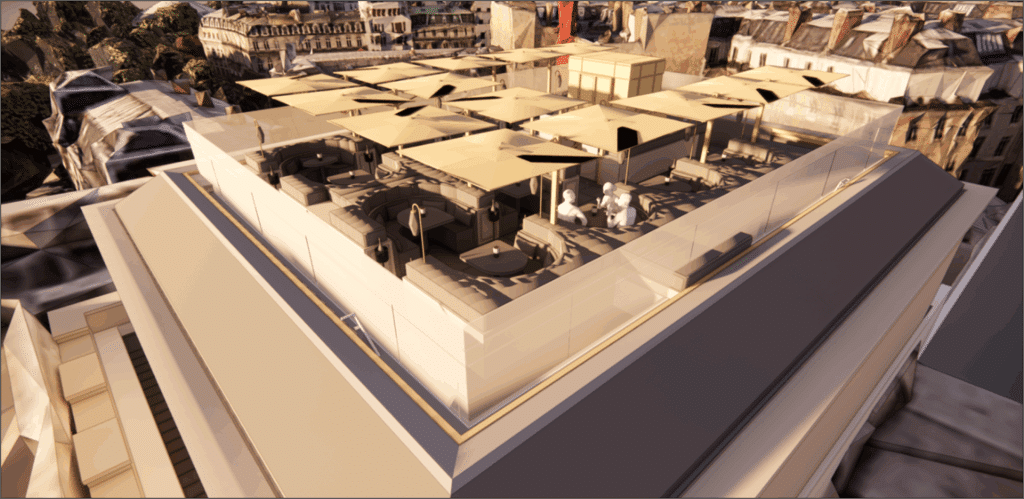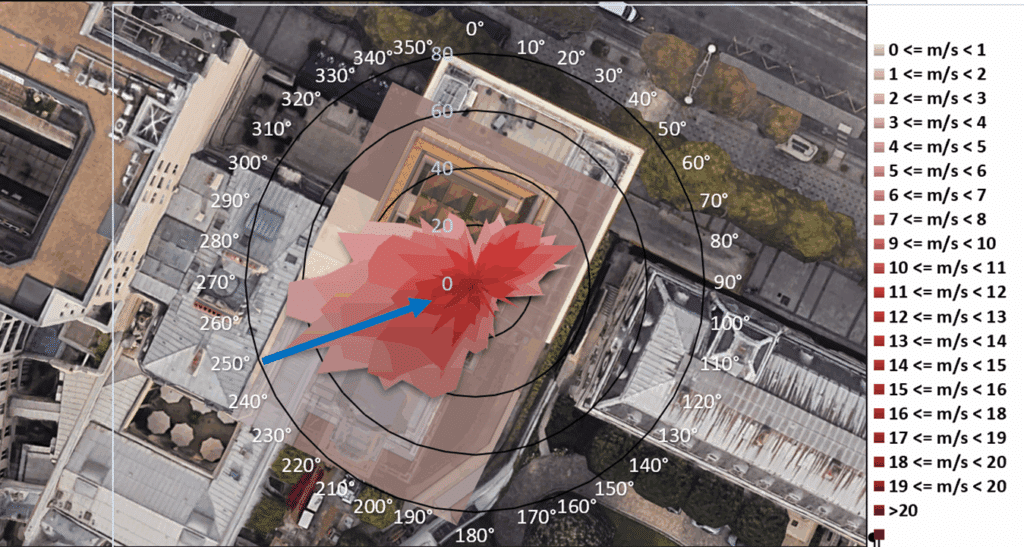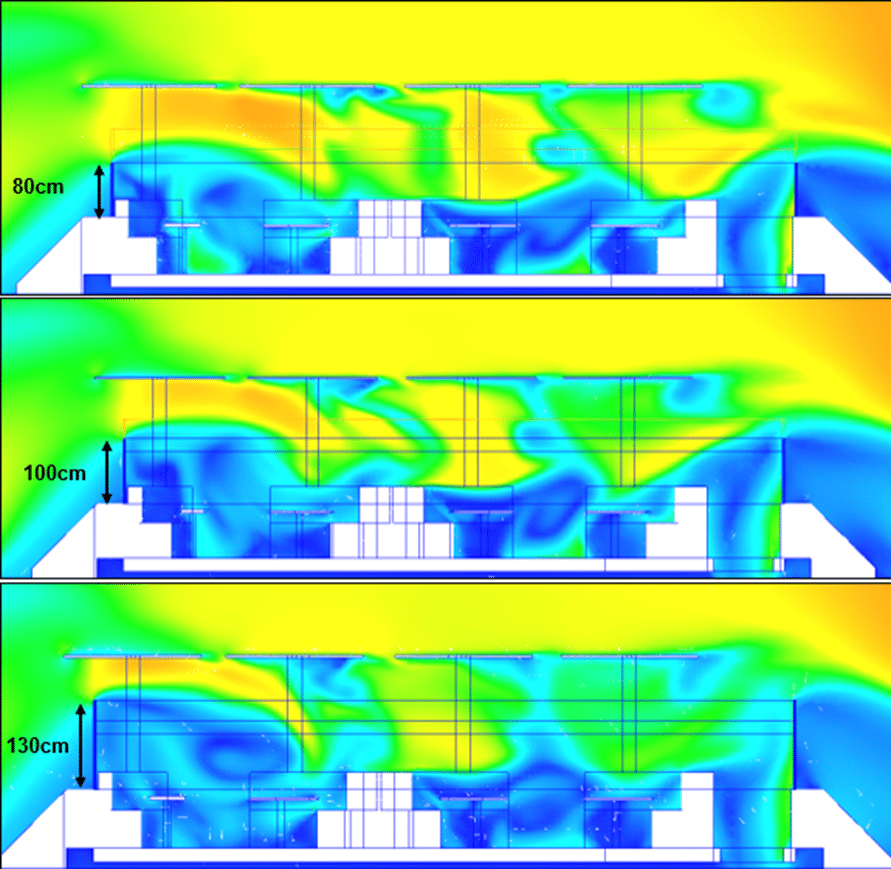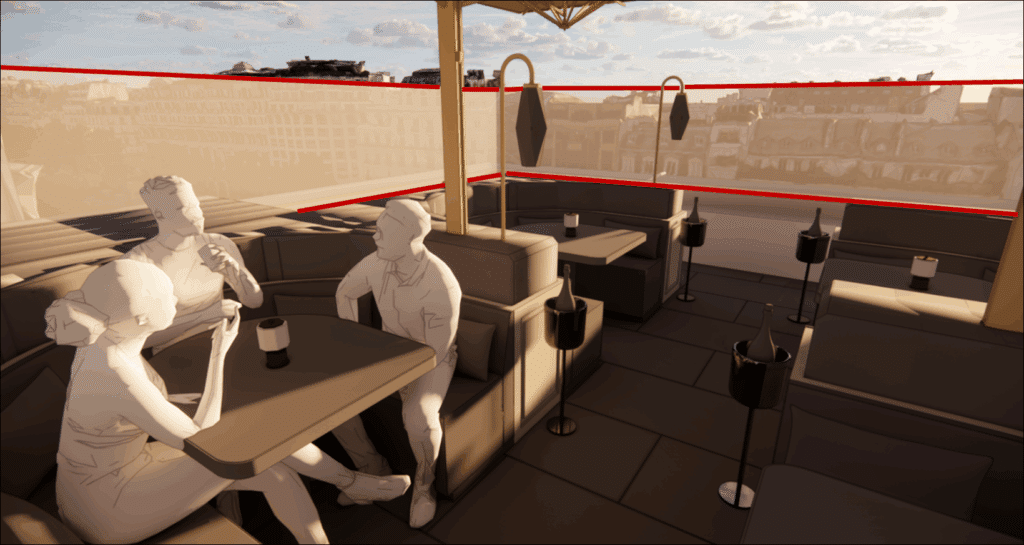Wind comfort study – Rooftop
Wind comfort study - Rooftop
Year
2025
Customer
NC
Location
France
Typology
Air & Wind
Home » Air & Wind » Numerical simulation of pedestrian comfort in an urban environment » Wind comfort study – Rooftop
Comfort in the wind on the rooftop of a Paris hotel
EOLIOS engineers are experts in modeling and optimizing aeraulic comfort.
Eolios Ingénierie recently carried out a wind comfort study for the rooftop of a luxury hotel in Paris.
Located in a dense urban environment, this rooftop terrace will be used by the public and must offer optimum aeraulic comfort despite its exposure to the wind. In the absence of adequate protection,wind acceleration or vortices caused by the shape of the building and the proximity of other buildings could generate zones of discomfort, or even danger, for users.
The aim of the study was to quantify the impact of wind on the terrace, and to assess the effectiveness of a glass windscreen of different heights in improving customer comfort on the terrace.
EOLIOS is a leader in external CFD simulation for aeraulic comfort. Our studies are based on feedback from real-life measurement campaigns and simulated sites around the world.
CFD simulation and airflow scenarios
3D modeling at the heart of the business
To meet these challenges, EOLIOS implemented a CFD (Computational Fluid Dynamics) numerical simulation to accurately model outdoor air flows around the hotel. The 3D model reproduces the building and its immediate surroundings, including neighbouring buildings in the direction of the prevailing wind, as well as all rooftop features (furniture, railings, parasols, etc.), in order to take into account all obstacles influencing airflow.
This approach makes it possible to visualize the exposed and protected zones on the terrace, depending on the layout envisaged.
Meteorological study: an essential element in CFD
Meteorological studies have shown thatÎle-de-France is not the windiest region in France, but that the prevailing summer winds are frequently from the west/south-west. In summer, a moderate south-westerly oceanic wind predominates, with occasional more sustained episodes (thunderstorms, intermittent north-easterly winds). On this basis, two typical wind conditions have been selected for the simulation:
- An average wind of 3.5 m/s fromwest-southwest (250°), representative of a typical summer breeze.
- A stronger wind of 8 m/s from the same direction, corresponding to a plausible but rarer case in July, to assess behavior in unfavorable situations.
For each of these wind conditions, three windscreen configurations were tested around the perimeter of the terrace: 80 cm, 100 cm and 130 cm high. The role of these glazed windscreens is to attenuate the wind felt by users, while preserving the view of the city. The study involves determining the extent to which each wall height improves comfort, and identifying any residual areas of discomfort.
External study: results of rooftop airflow analysis
Windscreen 80 cm
This height offers limited protection. For moderate winds, it manages to reduce speeds close to the ground, ensuring acceptable comfort at table level.
However, the wind quickly bypasses the obstacle: at face height, even in the seated position, sufficient speeds are recorded to cause slight discomfort.
For stronger winds, the 80 cm windscreen is clearly insufficient: sustained draughts can affect the seating area to a considerable extent, making the experience uncomfortable for customers. People standing or on the edge of the terrace are particularly exposed in this configuration.
Windscreen 100 cm
The moderate increase in height brings a significant gain. In medium winds, air velocities around the seats are reduced, ensuring satisfactory aeraulic comfort over most of the terrace.
At seated face height, residual air flows are less powerful than at 80 cm, which limits the risk of discomfort for seated customers. Nevertheless, some high areas remain windy. In strong winds, the 100 cm windscreen contains the flow better than a low wall: we measure a 15-25% reduction in perceived speeds compared to the 80 cm configuration, which improves comfort on the ground.
Even so, some local accelerations persist above the barrier – rapid peaks can still be seen at head height in exposed corners – showing that this solution, while effective in most situations, reaches its limits during episodes of very sustained wind.
Windscreen 130 cm
This configuration is particularly effective. With ~50 cm more than the original railing, it creates a veritable wind screen around the terrace. In moderate winds, residual speeds behind the wall become very low, ensuring maximum comfort for customers.
Even at face height(sitting or standing), the wind is largely slowed down, eliminating most of the unpleasant currents. In strong winds, the 130 cm windscreen continues to provide effective protection: speeds are reduced by around 30 to 40% compared to the 80 cm configuration, maintaining comfortable conditions in the seating area.
A few quick draughts remain above the wall, but their impact is limited to very high or unsheltered areas. Overall, this solution offers the best guarantee of comfort for all users, while providing sufficient natural ventilation.
Solutions to improve customer comfort
CFD analysis results for the rooftop
In view of these results, it is clear that increasing the height of the windscreen significantly improves wind comfort on the rooftop. A 130 cm-high glazed windscreen creates a sheltered microclimate on the terrace, where lower walls still let in annoying draughts.
Indeed, the use of judiciously placed transparent windscreens can effectively reduce the impact of strong winds, while preserving panoramic views for customers. This solution offers a dual advantage: increased comfort and aesthetic appeal (glass windscreens are unobtrusive and do not obstruct the view).
Customer recommendations
Eolios Ingénierie recommended the installation of a perimeter glass partition around the terrace, approximately 1.30 m high, to reduce wind speeds on the occupied space and create a comfortable zone for users.
According to the study, this preventive measure will enable guests to enjoy the rooftop in complete peace and quiet, even on windy days, without compromising the space’s openness to the outside world. By securing airflow comfort in this way, the rooftop of this Paris hotel will become a pleasant and attractive place to be, whatever the weather, contributing to an upscale guest experience.
EOLIOS ingénierie's expertise in solving aeraulic comfort problems
Recommendations tailored to each project
Thanks to its expertise in numerical simulation, and more specifically in fluid dynamics applied to built environments, EOLIOS was able to propose various solutions adapted to the project to mitigate the phenomena ofacceleration and turbulence on the rooftop. Simple, low-cost solutions, such as gradually increasing the height of the glazed windscreens, were considered. Complementary arrangements can also be studied, such asoptimizing the layout of furniture or integrating additional protection in certain exposed areas.
In-depth analysis of aeraulic comfort has also enabled a precise comparison of theefficiency of each configuration, providing a clear assessment of the benefits of the chosen solution in terms of quality of use and safety.
Thanks to this study, EOLIOS was able tooptimize the design of the rooftoplayout. This optimization will reduce the risk of draught-relateddiscomfort, while enhancing the value andattractiveness of thespace. What’s more, the design chosen will ensure a pleasant experience for users over the long term, whatever the wind conditions. An in-depth study could also quantify thecontribution in terms of visitor numbers and overall comfort for the entire terrace.
Find out more:
Video summary of the study
Summary of the study
EOLIOS Ingénierie carried out a wind comfort study for a public rooftop in a dense urban environment. Using CFD numerical simulation, airflows around the building and terrace fittings were modeled to identify areas exposed to acceleration and turbulence. Two typical wind conditions were studied, with moderate (3.5 m/s ) and more sustained (8 m/s) wind speeds. Three glazed windscreen heights (80 cm, 100 cm and 130 cm) were tested to assess their effectiveness.
The results show that the higher the wall, the more it reduces wind speeds at seat height, thus improving comfort. The 80 cm configuration remains insufficient in strong winds, while 100 cm offers a significant but limited gain. The optimum solution is a 130 cm glazed windscreen, which guarantees maximum comfort even in adverse conditions, while preserving the view and aesthetics of the terrace.
Video summary of the mission
Discover other data center projects
Study of aeraulic comfort – Middle school
Wind comfort study – Rooftop
Wind impacts on high-rise buildings: Tours Olympiades in Paris
Comfort – Rooftop of a palace – Casablanca
Tour Liberté – La Défense
Impact of wind on a solar power plant
Cooling towers – ICPE
Pedestrian comfort study – La Défense
Confort au Vent – PSG training center
Wind study – La Défense
Fine particle capture in a metro station
Sharaan by Jean Nouvel resort
Air coolers – Critical study – Heat wave
Fine dust measurements
Balenciaga – Wind potential

